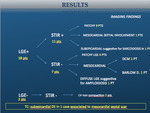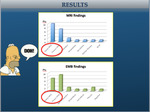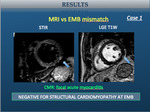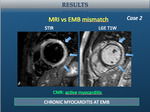Purpose
Symptoms related to the sudden occurrence of ventricular arrhythmias (VA) remains frequently a diagnostic and therapeutic challenge,
after exclusion of coronary artery disease.
Universally accepted professional guidelines are not available,
but the correct diagnosis is essential to tailer patients management and for risk stratification.
Aim was to evaluate the role of cardiacMR (CMR) and Delayed Enhanced Computed Tomography (DECT) in the identification of myocardial disease responsible of VA onset,
comparing imaging findings to histological essays.
Methods and Materials
23 patients (pts) (XX/XY:6/17,
mean FE: 49%±16%) with sudden occurrence of palpitation/lipothymia-hypotension related to the onset of previously unknown VA were enrolled.
20 patients underwent CMR including edema sensitive T2w-STIR and delayed post-gadolinium IR T1w sequences.
The remaining 3 patients with contraindication to CMR,
underwent DECT including a delayed low-energy (80 kV) scan for scars identification.
Blinded,
endomyocardial biopsy (EMB) was performed,
and results compared to imaging findings.
Results
In 19/23 patients imaging features were suggestive for inflammatory cardiomyopathy (11/19 acute myocarditis,
7/19 prior myocarditis,
1/19 cardiac sarcoid).
In the remaining four cases cardiac imaging showed cardiac amyloidosis,
initial idiopathic dilated cardiomyopathy and two cases of left ventricle non-compaction(Fig.1).
EMB confirmed the imaging diagnosis in 20 out of 23 patients (Fig.2); 1 patient with evidence of focal myocarditis at CMR had a negative EMB (Fig.3),
while 2 patients diagnosed as acute myocarditis at CMR had EMB findings suggestive for chronic myocarditis (Fig.4).
Conclusion
Inflammatory cardiomyopathy is the most frequent diagnosis in patients with this arrhythmic presentation.
Non invasive imaging,
overall CMR,
allows a comprehensive morpho-functional evaluation of heart,
useful for the identification of structural cardiomyopathy responsible of ventricular arrhythmias.
In case of Inflammatory cardiomyopathy allow the evaluation of active disease,
overcoming the well known limit of sampling of EMB.CMR,
or DECT when CMR is contraindicated,
may help in the management of these patients,
indicating the correct diagnosis and avoiding the need of further investigation with EMB.





